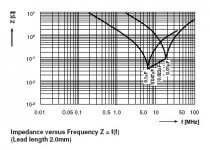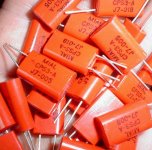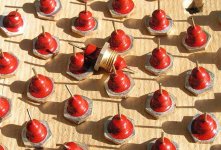Since I use 50 MHz GBW op-amps (which probably makes me pond scum), lead length is important and it doesn't take much of a bad layout to cause problems. 4 MHz self resonance doesn't inspire much confidence. Discrete designers shouldn't get too comfy either- take a look at the GBW of a lot of common small signal transistors. Remember, the devices are completely unaware that they're in an audio frequency circuit.
syn08 said:
OTOH, film caps usually have a significant internal ESL, due to the rolled foil construction. This makes reaching those 16nH (internal inductance plus terminals plus PCB traces) much easier.
Bottom line, film caps are inferior when it comes to self resonance. This applies to SMD parts as well, although the resonance frequencies are much higher.
.
m.b. picture from the data sheet shows resonance f. of the Vishay MKP1837 series
for 0,1uF I would say is around 6-7MHz
internal inductance according to the data is 6nH
Lead ceramic disc cap X7R has resonance f. around 10MHz and self inductance around 2,5-3nH
Attachments
A few days ago, Jonathan dropped a hint on a digital source :
http://www.diyaudio.com/forums/showthread.php?postid=1800535#post1800535
I wonder if these hand-held things can accomodate film caps for PS decoupling.
And then I was looking at how Borbely was implementing his DAC :
http://www.borbelyaudio.com/pics/HB_DAC1704_V2_0.pdf
Those SMD thingie must be special silver micas ???

Patrick
http://www.diyaudio.com/forums/showthread.php?postid=1800535#post1800535
I wonder if these hand-held things can accomodate film caps for PS decoupling.
And then I was looking at how Borbely was implementing his DAC :
http://www.borbelyaudio.com/pics/HB_DAC1704_V2_0.pdf
Those SMD thingie must be special silver micas ???

Patrick
EUVL said:
And then I was looking at how Borbely was implementing his DAC :
http://www.borbelyaudio.com/pics/HB_DAC1704_V2_0.pdf
Those SMD thingie must be special silver micas ???

Patrick
The HB-DAC1704 design is the intellectual property of Hannes Frederiks. All rights reserved.
😀
OK, let's clear this up. We all know that without ANY inductance that the self resonance of any cap would be very, very, high, if not infinity. But inductance is ALWAYS present in the leads (if any) and this works with the fixed capacitance to make some resonant frequency.
Often, as a rule of thumb, with quality polystyrene, and polypropylene caps, properly made, I have found 4MHz with .1uf. to be typical.
However, there is a discrepancy that I learned from Scott Wurcer, 25 years ago, when I was making laser modulators for medical instrumentation.
I, then, was assigned to making a 30MHz, 50W power amp, and I had never done one before. This power amp, also had to be turned off and on very quickly.
I needed better supply bypassing than what I had ever used before, and I asked Scott to help me. He sent me an entire file of information on multiple cap power supply decoupling which he had shown by actual measurement to really work well.
It consisted of a 22uf tantalum, a .1uf (Erie Red Cap) and 1000pf mica, all in parallel, as I recall.
It worked for me! However, over the years, I lost the info on the .1 Erie Red Cap, but now I might presume, as it was a designated RF capacitor, that it was made of X7R material, rather than 5YV, that I have normally seen used in telecommunication equipment. It WAS somewhat larger than the equivalent 5YV of similar value, so that must be it. Therefore, the significantly higher self resonant frequency of 20MHz is a welcome addition to the family of caps, and certainly could be useful in digital bypassing, for sure.
I appreciate that Syn08 pointed this out to me. However, let us also understand that not all polystyrene caps are made the same way, and that many are pretty darn good. However, others could be made cheaply and have significantly reduced performance. It depends often on the manufacturer. Rel caps are pretty darn good. It must be remembered that lead length COMPLETELY dominates when the leads are over 1/2 inch or so. Therefore, the self resonance can be completely lost in actual connection, except for the Q of the resonance, which is material and construction related. This can be very important with smaller caps and at microwave frequencies, 7XR might be rejected, and only NPO or better materials used exclusively.
Often, as a rule of thumb, with quality polystyrene, and polypropylene caps, properly made, I have found 4MHz with .1uf. to be typical.
However, there is a discrepancy that I learned from Scott Wurcer, 25 years ago, when I was making laser modulators for medical instrumentation.
I, then, was assigned to making a 30MHz, 50W power amp, and I had never done one before. This power amp, also had to be turned off and on very quickly.
I needed better supply bypassing than what I had ever used before, and I asked Scott to help me. He sent me an entire file of information on multiple cap power supply decoupling which he had shown by actual measurement to really work well.
It consisted of a 22uf tantalum, a .1uf (Erie Red Cap) and 1000pf mica, all in parallel, as I recall.
It worked for me! However, over the years, I lost the info on the .1 Erie Red Cap, but now I might presume, as it was a designated RF capacitor, that it was made of X7R material, rather than 5YV, that I have normally seen used in telecommunication equipment. It WAS somewhat larger than the equivalent 5YV of similar value, so that must be it. Therefore, the significantly higher self resonant frequency of 20MHz is a welcome addition to the family of caps, and certainly could be useful in digital bypassing, for sure.
I appreciate that Syn08 pointed this out to me. However, let us also understand that not all polystyrene caps are made the same way, and that many are pretty darn good. However, others could be made cheaply and have significantly reduced performance. It depends often on the manufacturer. Rel caps are pretty darn good. It must be remembered that lead length COMPLETELY dominates when the leads are over 1/2 inch or so. Therefore, the self resonance can be completely lost in actual connection, except for the Q of the resonance, which is material and construction related. This can be very important with smaller caps and at microwave frequencies, 7XR might be rejected, and only NPO or better materials used exclusively.
Not all ceramic caps are made the same way either, i gathered that Mr Popa (and his associates) merely challenges the 0-100pF range.
(plus availability/cost, and generalisations such as these )
For the garbage container day scavengers, Philips Mial PGP-olystyrene (maid in Germany) =>
(plus availability/cost, and generalisations such as these )
For the garbage container day scavengers, Philips Mial PGP-olystyrene (maid in Germany) =>
Attachments
Wavebourn said:Here are some ceramics I have...
RF chassis bypass caps, most likely Russians, mid 70's.
syn08 said:
RF chassis bypass caps, most likely Russians, mid 70's.
You are right again.
- Status
- Not open for further replies.
- Home
- Amplifiers
- Solid State
- ceramic capacitors ....


